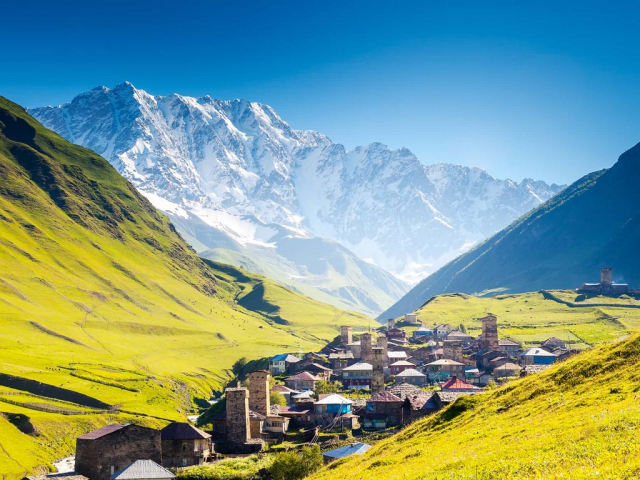
Top 7 winter drinks from around the world
Winter is the perfect time to curl up in a warm blanket and enjoy drinks that bring coziness and holiday cheer. Here are seven winter drinks that are perfect for cold days




The CIS countries that have assets traded in the international financial markets can be conditionally divided into three groups. The most favorable prospects are for Georgia and Kazakhstan. The economic models of Armenia and Belarus are not so developed, but their prospects for the coming years are also quite positive. The third group, which includes Ukraine, Tajikistan, and Azerbaijan, may face certain difficulties. Now let's consider each of the groups in more detail.

Georgia and Kazakhstan
According to the Renaissance Capital forecasts, Georgia will show one of the highest rates of economic growth among all countries of the region in 2018-2019 - about 4.5%. Among other things, Georgia has a strong banking sector, close cooperation with the IMF, and a blossoming tourism industry; this year, according to experts, the number of tourists will exceed the country's population.

Kazakhstan will be a leader among the CIS countries as an oil producer - more than 3.5% in 2018-2019 at an average annual price of $55-62 per barrel. Among the additional benefits of Kazakhstan is the strengthening of the banking sector and the infrastructure development.
Today, the national currencies, Georgian lari and Kazakh tenge, have a fair assessment - in both countries, inflation and rates can be expected to decrease. The target inflation rate since 2020 in Georgia is 3%, in Kazakhstan - 4% or lower. Besides, both countries have already taken significant steps towards greater fiscal discipline.

Armenia and Belarus
These countries have more modest economic prospects, but at the same time they serve as direct beneficiaries of higher commodity prices, and they better interact with Russia than others. The GDP growth in Armenia (7.5%) and Belarus (2.4%) exceeded the expectations of the IMF and other market participants.

The main concerns about the economy of Armenia are generally related to the fact that the rate of the Armenian dram to the world currencies has decreased most notably in comparison with the exchange rates of other countries of the region. But Armenia has improved the current account deficit from 8% of GDP in 2012 to just 2-3% in 2016-2017 without currency devaluation. Even if it grows to 3-4%, further weakening is not required. So it's not worth exaggerating the risks relative to the national currency.

As for Belarus, the concerns are usually related to the balance of foreign currency spending and incomings. According to some experts, the Belarusian government and the National Bank have enough sources that can cover currency payments by the end of next year.
In any case, if we are talking about investments in the CIS countries, then Georgia and Kazakhstan, Armenia and Belarus are considered to be the top four.

Azerbaijan
The three outsiders include Azerbaijan, Ukraine, and Tajikistan. Each of these countries has its own difficulties. Thus, macroeconomic recovery in Azerbaijan is hampered by a decline in oil production and an ineffective economic policy to the fact of a past decline in oil prices. However, the country has solid financial buffers in the form of reserves, which cover more than 50 months of imports. And the macroeconomic situation in 2018-2019 will noticeably improve in comparison with 2016-2017 years.

Ukraine
The country lacks clarity in relation to the new economic model, moreover, there are obvious obstacles to the implementation of large-scale reforms which at the time were carried out in Georgia. Both can lead to noticeable difficulties, given that the Ukrainian economy demonstrates the highest level of external debt in the region.

Tajikistan
The level of economic development of Tajikistan is simply much lower than other countries in the region. The country's GDP per capita is less than $1,000, or only 8% of the Russian one. For this reason, the country was in the top three outsiders.
The diversity of countries in economic terms allows different groups of investors to find interest among the assets of the CIS countries.

Assets for investments
All considered countries have tradable corporate Eurobonds, as well as Eurobonds in Russian rubles or national currency. Thus, in Kazakhstan, ruble bonds of the Kazakhstan Temir Zholy state railway company (KTZ) are circulating. In addition, the Bank of Georgia has an opportunity to issue international bonds in local currency, which is organized outside the country.
Finally, Georgia and Kazakhstan are classified as "frontier" markets for equity investors.
Recently, there has also been the renewed attention of equity investors to the stock market of Ukraine.

Winter is the perfect time to curl up in a warm blanket and enjoy drinks that bring coziness and holiday cheer. Here are seven winter drinks that are perfect for cold days

Despite the widespread belief that ultra-wealthy individuals are leaving big cities in search of privacy, most still prefer to live in bustling metropolises, according to the latest billionaire census conducted by Altrata. Let's explore which cities today have the largest concentration of people with a fortune exceeding $1 billion

The European Union currently includes 27 member states, but the interest in joining continues to grow, with an increasing number of countries aspiring to become part of the bloc. This article highlights the countries advancing toward European integration and examines where they stand on this path